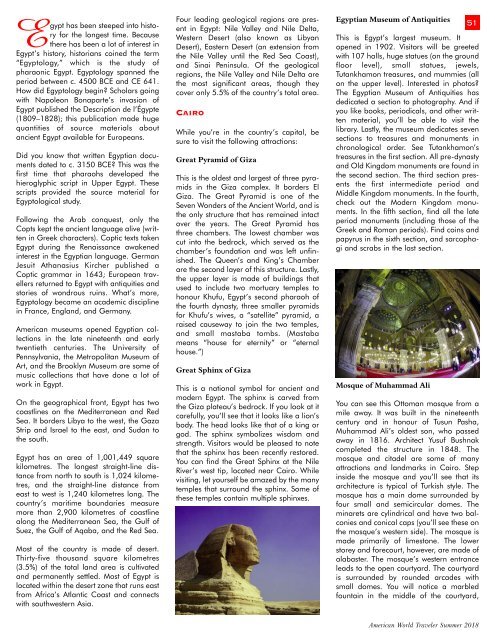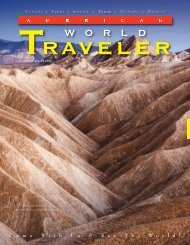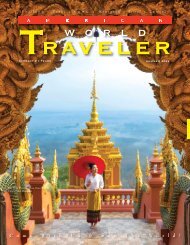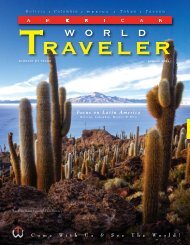American World Traveler Summer 2018 Issue
Now in our 16th year of publishing, American World Traveler explores the culture and history of worldwide destinations, sharing the adventure of discovery with our readers and motivating them to make their travel dreams a reality. Published quarterly, AWT helps sophisticated, independent American travelers choose their next destination by offering a lively blend of intelligent, informative articles and tantalizing photographic images from our World’s best destinations, cruises, accommodations and activities to suit every traveler's taste.
Now in our 16th year of publishing, American World Traveler explores the culture and history of worldwide destinations, sharing the adventure of discovery with our readers and motivating them to make their travel dreams a reality. Published quarterly, AWT helps sophisticated, independent American travelers choose their next destination by offering a lively blend of intelligent, informative articles and tantalizing photographic images from our World’s best destinations, cruises, accommodations and activities to suit every traveler's taste.
You also want an ePaper? Increase the reach of your titles
YUMPU automatically turns print PDFs into web optimized ePapers that Google loves.
Egypt has been steeped into history<br />
for the longest time. Because<br />
there has been a lot of interest in<br />
Egypt’s history, historians coined the term<br />
“Egyptology,” which is the study of<br />
pharaonic Egypt. Egyptology spanned the<br />
period between c. 4500 BCE and CE 641.<br />
How did Egyptology begin? Scholars going<br />
with Napoleon Bonaparte’s invasion of<br />
Egypt published the Description de l’Égypte<br />
(1809–1828); this publication made huge<br />
quantities of source materials about<br />
ancient Egypt available for Europeans.<br />
Did you know that written Egyptian documents<br />
dated to c. 3150 BCE? This was the<br />
first time that pharaohs developed the<br />
hieroglyphic script in Upper Egypt. These<br />
scripts provided the source material for<br />
Egyptological study.<br />
Following the Arab conquest, only the<br />
Copts kept the ancient language alive (written<br />
in Greek characters). Coptic texts taken<br />
Egypt during the Renaissance awakened<br />
interest in the Egyptian language. German<br />
Jesuit Athanasius Kircher published a<br />
Coptic grammar in 1643; European travellers<br />
returned to Egypt with antiquities and<br />
stories of wondrous ruins. What’s more,<br />
Egyptology became an academic discipline<br />
in France, England, and Germany.<br />
<strong>American</strong> museums opened Egyptian collections<br />
in the late nineteenth and early<br />
twentieth centuries. The University of<br />
Pennsylvania, the Metropolitan Museum of<br />
Art, and the Brooklyn Museum are some of<br />
music collections that have done a lot of<br />
work in Egypt.<br />
On the geographical front, Egypt has two<br />
coastlines on the Mediterranean and Red<br />
Sea. It borders Libya to the west, the Gaza<br />
Strip and Israel to the east, and Sudan to<br />
the south.<br />
Egypt has an area of 1,001,449 square<br />
kilometres. The longest straight-line distance<br />
from north to south is 1,024 kilometres,<br />
and the straight-line distance from<br />
east to west is 1,240 kilometres long. The<br />
country’s maritime boundaries measure<br />
more than 2,900 kilometres of coastline<br />
along the Mediterranean Sea, the Gulf of<br />
Suez, the Gulf of Aqaba, and the Red Sea.<br />
Most of the country is made of desert.<br />
Thirty-five thousand square kilometres<br />
(3.5%) of the total land area is cultivated<br />
and permanently settled. Most of Egypt is<br />
located within the desert zone that runs east<br />
from Africa’s Atlantic Coast and connects<br />
with southwestern Asia.<br />
Four leading geological regions are present<br />
in Egypt: Nile Valley and Nile Delta,<br />
Western Desert (also known as Libyan<br />
Desert), Eastern Desert (an extension from<br />
the Nile Valley until the Red Sea Coast),<br />
and Sinai Peninsula. Of the geological<br />
regions, the Nile Valley and Nile Delta are<br />
the most significant areas, though they<br />
cover only 5.5% of the country’s total area.<br />
Cairo<br />
While you’re in the country’s capital, be<br />
sure to visit the following attractions:<br />
Great Pyramid of Giza<br />
This is the oldest and largest of three pyramids<br />
in the Giza complex. It borders El<br />
Giza. The Great Pyramid is one of the<br />
Seven Wonders of the Ancient <strong>World</strong>, and is<br />
the only structure that has remained intact<br />
over the years. The Great Pyramid has<br />
three chambers. The lowest chamber was<br />
cut into the bedrock, which served as the<br />
chamber’s foundation and was left unfinished.<br />
The Queen’s and King’s Chamber<br />
are the second layer of this structure. Lastly,<br />
the upper layer is made of buildings that<br />
used to include two mortuary temples to<br />
honour Khufu, Egypt’s second pharaoh of<br />
the fourth dynasty, three smaller pyramids<br />
for Khufu’s wives, a “satellite” pyramid, a<br />
raised causeway to join the two temples,<br />
and small mastaba tombs. (Mastaba<br />
means “house for eternity” or “eternal<br />
house.”)<br />
Great Sphinx of Giza<br />
This is a national symbol for ancient and<br />
modern Egypt. The sphinx is carved from<br />
the Giza plateau’s bedrock. If you look at it<br />
carefully, you’ll see that it looks like a lion’s<br />
body. The head looks like that of a king or<br />
god. The sphinx symbolizes wisdom and<br />
strength. Visitors would be pleased to note<br />
that the sphinx has been recently restored.<br />
You can find the Great Sphinx at the Nile<br />
River’s west tip, located near Cairo. While<br />
visiting, let yourself be amazed by the many<br />
temples that surround the sphinx. Some of<br />
these temples contain multiple sphinxes.<br />
Egyptian Museum of Antiquities<br />
This is Egypt’s largest museum. It<br />
opened in 1902. Visitors will be greeted<br />
with 107 halls, huge statues (on the ground<br />
floor level), small statues, jewels,<br />
Tutankhamon treasures, and mummies (all<br />
on the upper level). Interested in photos?<br />
The Egyptian Museum of Antiquities has<br />
dedicated a section to photography. And if<br />
you like books, periodicals, and other written<br />
material, you’ll be able to visit the<br />
library. Lastly, the museum dedicates seven<br />
sections to treasures and monuments in<br />
chronological order. See Tutankhamon’s<br />
treasures in the first section. All pre-dynasty<br />
and Old Kingdom monuments are found in<br />
the second section. The third section presents<br />
the first intermediate period and<br />
Middle Kingdom monuments. In the fourth,<br />
check out the Modern Kingdom monuments.<br />
In the fifth section, find all the late<br />
period monuments (including those of the<br />
Greek and Roman periods). Find coins and<br />
papyrus in the sixth section, and sarcophagi<br />
and scrabs in the last section.<br />
Mosque of Muhammad Ali<br />
51<br />
You can see this Ottoman mosque from a<br />
mile away. It was built in the nineteenth<br />
century and in honour of Tusun Pasha,<br />
Muhammad Ali’s oldest son, who passed<br />
away in 1816. Architect Yusuf Bushnak<br />
completed the structure in 1848. The<br />
mosque and citadel are some of many<br />
attractions and landmarks in Cairo. Step<br />
inside the mosque and you’ll see that its<br />
architecture is typical of Turkish style. The<br />
mosque has a main dome surrounded by<br />
four small and semicircular domes. The<br />
minarets are cylindrical and have two balconies<br />
and conical caps (you’ll see these on<br />
the mosque’s western side). The mosque is<br />
made primarily of limestone. The lower<br />
storey and forecourt, however, are made of<br />
alabaster. The mosque’s western entrance<br />
leads to the open courtyard. The courtyard<br />
is surrounded by rounded arcades with<br />
small domes. You will notice a marbled<br />
fountain in the middle of the courtyard,<br />
<strong>American</strong> <strong>World</strong> <strong>Traveler</strong> <strong>Summer</strong> <strong>2018</strong>
















